Annual Report, 2001 Field Season
By Susan C. Ryan
Introduction
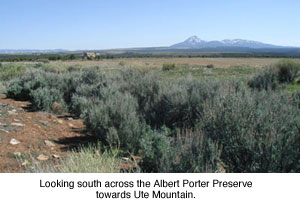 The Albert
Porter Preserve (Site 5MT123) was a densely populated ancestral Puebloan
village with a primary occupation dating from the Pueblo II (A.D. 900–1150)
and Pueblo III periods (A.D. 1150–1300) and an extended occupation
thought to have begun either in the Basketmaker III or the Pueblo I period
(A.D. 600–900) (Figure 1). The Albert Porter
Preserve is a 12-acre parcel located on a mesa top between Sandstone and
Woods canyons in Montezuma County, Colorado. In 1988, the 12-acre parcel
was donated by members of the Porter family to the Archaeological Conservancy who subsequently granted the Crow Canyon Archaeological Center permission
to conduct a research project at the Preserve. This report summarizes
the Crow Canyon Archaeological Center's research design and the first
season (2001) of work at the Albert Porter Preserve.
The Albert
Porter Preserve (Site 5MT123) was a densely populated ancestral Puebloan
village with a primary occupation dating from the Pueblo II (A.D. 900–1150)
and Pueblo III periods (A.D. 1150–1300) and an extended occupation
thought to have begun either in the Basketmaker III or the Pueblo I period
(A.D. 600–900) (Figure 1). The Albert Porter
Preserve is a 12-acre parcel located on a mesa top between Sandstone and
Woods canyons in Montezuma County, Colorado. In 1988, the 12-acre parcel
was donated by members of the Porter family to the Archaeological Conservancy who subsequently granted the Crow Canyon Archaeological Center permission
to conduct a research project at the Preserve. This report summarizes
the Crow Canyon Archaeological Center's research design and the first
season (2001) of work at the Albert Porter Preserve.
Fieldwork during
the 2001 season was conducted from April through October, under State
of Colorado Archaeological Permit Number 2001-19. An electronic site report
will be available on Crow Canyon's Web site upon completion of all research
and analyses at the Albert Porter Preserve.
Previous Research
Limited research has
previously been conducted at the Albert Porter Preserve. A Colorado state
site form was completed in 1965 as part of a University of Colorado survey.
During the survey, a small number of artifacts were collected and are
presently curated at the Anasazi Heritage Center in Dolores, Colorado.
In the early 1980s, a sketch map of "Hedrick Ruin" (the original
name for the preserve) was compiled by Art Rohn of Wichita State University.
In the late 1980s, Mark Chenault, then a graduate student at the University
of Colorado, used a transit to create a more detailed map of the site.
In 1994, the Crow Canyon Archaeological Center, in collaboration with
Washington State University, conducted the Village Mapping Program (Lipe
and Ortman 2000), using aerial photography to produce a topographic
map. An AutoCAD map of the preserve was then created using these maps
and a laser transit. On the basis of the Architectural Block 100 ruins,
the Albert Porter Preserve was nominated to the National Register of Historic
Places in 1995 as an example of a habitation site with public architecture
(Lipe 1999).
Architectural block
areas and extramural boundaries were added to the AutoCAD map during the
2001 field season. Architectural Block 100 has architectural characteristics
unique to the preserve in that it contains multistoried rooms and what
appear to be blocked-in pit structures. This architectural block has been
interpreted as a Chacoan great house and was probably the center of the
community. A community center is defined by a large residential and public
building or great house, surrounded by smaller, contemporary residential
buildings (Adler and Varien 1994; Varien
1999b). It is believed that the Albert Porter Preserve served as a
community center during the Chacoan Period, A.D. 1050–1150, and the
post-Chaco period, A.D. 1150–1225.
Current Research
Research at the Albert
Porter Preserve is guided by the Crow Canyon Archaeological Center’s
current research design titled "Communities Through Time: Migration,
Cooperation, and Conflict," and designed to examine the development and
depopulation of ancestral Puebloan communities in the Mesa Verde region
between A.D. 900 and 1300. More specifically, data is gathered and examined
at the residential site level, community level, and regional level.
Test excavations at
the Albert Porter Preserve will result in the collection of ecofacts and
artifacts which will provide data at the residential site level. These
data will be obtained from each architectural block on the site (Figure
2). Midden deposits will be sampled with 1-x-1-m units; pit structures
will be sampled with 2-x-2-m units that will be reduced to 1-x-2-m units
when roof-fall deposits are discovered.
Crow Canyon has also
conducted research at two other sites in the vicinity of Albert Porter
Preserve. Woods Canyon Pueblo (Site 5MT11842) and Woods Canyon Reservoir
(Site 5MT12086) are located approximately 1.8 km from Albert Porter (Figure
3), and both were test-excavated in the 1990s (Churchill
[2001] and Wilshusen et al. [1997]).
The results of our investigations at these sites will allow us to document
the similarities and differences between Puebloan residences and better
understand the development of the Woods Canyon community.
At the regional level,
we will compare data from the Woods Canyon community with 27 similar communities
in the Mesa Verde region (Varien 1999b; Varien et al.1996; Ortman
et al. 2000).
Our research goals
at the Albert Porter Preserve are three-fold: (1) to date each period
of occupation; (2) to determine if the occupation was continuous or discontinuous;
and (3) to estimate the number of individuals who inhabited the preserve
during each period. Research results will then be used to examine two
broader questions crucial to understanding the culture history of the
northern San Juan region: (1) to what extent is there an identifiable
Chacoan influence at the Albert Porter Preserve; and (2) is there a visible
change in community organization during the post-Chaco period (A.D. 1130–1280)?
Documenting changes in community organization will allow us to identify
and study the Albert Porter Preserve as a community center. Other areas
of anthropological interest, such as the existence and function of leadership
roles, the construction and use of public architecture, and the development
of social inequality, if it existed, will also be studied.
Field Methods, 2001 Season
Fieldwork conducted
at the Albert Porter Preserve is consistent with the principals of conservation
archaeology (Lipe 1974). Specific fieldwork
methods used can be found in the Crow Canyon Archaeological Center’s
on-line Field
Manual. In accordance with our research design, less than two percent
of the site will be disturbed through excavations, leaving the majority
of the Albert Porter Preserve intact for future study. Our initial work
at the Albert Porter Preserve evaluated surface contexts from which specific
areas were targeted for detailed research. During the 2001 field season,
two contexts were selected for study, the nonarchitectural stratified
cultural deposits (middens) and the pit structures. Between five and 10
percent of each identified midden deposit will be tested with a 1-x-1-m
unit and approximately 15 percent of pit structure floors will be exposed
with one 1-x-2-m unit in each.
Testing nonarchitectural
stratified cultural deposits with randomly selected 1-x-1-m units will
provide artifact assemblage data. Artifact analysis data will be used
to address several research domains at the Albert Porter Preserve, including
chronology, diet, trading networks, environmental reconstruction, and
the types of activities that occurred in discrete areas of the preserve.
The diversity of artifact types is directly correlated to sample size
(Jones et al.1983), and artifact data
from the site will be used in comparative intersite and intrasite studies.
Thus, recovered samples should be large to ensure that the greatest possible
diversity of artifacts are collected and variation between assemblages
is not a direct result of sample size. To obtain a statistically valid
artifact assemblage, ten 1-x-1-m units will be excavated in middens with
areas between 100 and 200 sq m; this will result in the excavation of
between five and 10 percent of these contexts. In middens smaller than
100 sq m, 10 percent of the midden area will be excavated. Middens larger
than 200 sq m will be tested with 15 1-x-1-m units, or five percent of
these contexts.
Pit structures at
the Albert Porter Preserve were tested with 2-x-2-m units that were reduced
to 1-x-2-m units when roof-fall deposits were discovered, thus exposing
approximately 15 percent of the structure floor. Testing pit structures
will provide detailed information on four crucial levels. First, it is
hoped that tree-ring samples will provide chronological information for
each period of occupation at the preserve. Research has indicated that
pit structures are the most commonly burned type of building in the northern
San Juan region (Cameron 1990; Wilshusen
1988); therefore, pit structures will be heavily relied upon for chronological
data. Second, ash collected from structure hearths will provide information
on environmental conditions, structure function, diet, and economic indicators
of the individuals who occupied the structure (Adams
1999). During the 2001 field season, a small sample of ash was collected
from six completed pit structure units (averaging 12 liters each) for
flotation analysis; half to three-fourths of these hearth fills were left
in situ for future research. Third, examining pit structures will provide
crucial information on architectural construction in the Mesa Verde region.
Because Architectural Block 100 is thought to be a Chacoan great house,
it is important to identify the masonry style as Mesa Verde or Chaco.
Key architectural features in this distinction include the overall structure
shape, pilaster style, masonry style, and ventilation system. Fourth,
although no deliberate attempt was made to locate human bone in the pit
structures at Albert Porter, human bone, when identified, was documented
but not excavated.
Electrical Resistance Survey Results
In July, 2001, an electrical resistance survey was conducted by Fort Lewis College (FLC) in collaboration with the Crow Canyon Archaeological Center. Forty 20-x-20-m grids, or 16,000 sq m, were selected for survey, including areas north, east, west, and south-east of Architectural Block 100, the presumed great house. Architectural Block 100 itself was not surveyed because structure outlines are visible on the modern ground surface. The electrical resistance survey was conducted with a Geoscan RM15 Resistance Meter with a twin-probe array. The probes were positioned .5 m apart and data were recorded once every square meter (Charles and Ball 2001). Results of the resistance survey indicate the presence of 36 possible pit structures (Table 1, Figure 4, Figure 5), multiple linear features representing possible footpaths or roads, possible middens and surface rooms, natural bedrock formations, and a CO2 pipeline on the extreme eastern portion of the Albert Porter Preserve. The presence of these potential structures more than doubles the number of architectural features identified from the modern ground surface. Because the resistance survey was conducted midway through the 2001 field season, the original research design did not address the testing of these anomalies to confirm the presence of cultural features. An updated research design will be submitted to the Archaeological Conservancy during the winter of 2002 that proposes limited testing of key anomalies and associated middens. If approved, anomaly testing will begin during the 2002 field season.
Field Personnel, 2001 Field Season
The following individuals contributed to fieldwork at the Albert Porter Preserve during the 2001 field season: Susan Ryan, project director; Hugh Robinson, Erin Baxter, and Chris Horting, research archaeologists; Robyn Watkins-Morris, research intern and research archaeologist; Elizabeth Newman, Cristina Peterson, and Chris Bevilacqua, research interns; and Menno VanderHeiden, research volunteer. In addition, the Crow Canyon education staff and numerous Crow Canyon participants took part in our research during the 2001 field season.
Excavations, 2001 Field Season
Excavations during the 2001 field season were carried out within portions of five defined block areas—architectural blocks 100, 200, 300, 400, and 500. Randomly selected 1-x-1-m units were excavated in nonarchitectural midden deposits in architectural blocks 100, 200, 300, 400, and 500. Judgmentally placed 2-x-2-m units were excavated in pit structures in architectural blocks 100, 300, 400, and 500. Table 2 provides information on excavation units by block; it also provides average depth, information about the presence of a feature or structure, and whether the unit was completed during the 2001 field season. In the following block and structure summaries, discussions of dating and construction sequence are based on pottery type and assemblage data (following Wilson and Blinman [1991]), as well as on stratigraphic observations made in the field. Tree-ring dates are not yet available.
Architectural Block 100
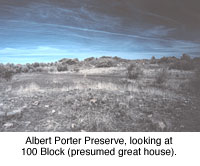 During
the 2001 field season, five 1-x-1-m units were excavated to test a midden
deposit, and eight 2-x-2-m units were excavated to test pit structures
(Figure 2, Figure 6).
Five 1-x-1-m units were placed in Nonstructure 103, a midden deposit thought
to be associated with Structure 107 and Structure 119. Two 1-x-1-m units
(469N 519E and 472N 518E) contained dense midden deposits, but no midden
was found in the three other units. A pit feature was documented in 1-x-1-m
unit, 469N 519E. The basin-shaped pit was 46 cm wide, 58 cm long, and
it was 22 cm deep. The function of the pit is unknown due to the absence
of features but is most likely indicative of a extramural use area. Secondary
refuse was deposited into the pit after it fell out of use.
During
the 2001 field season, five 1-x-1-m units were excavated to test a midden
deposit, and eight 2-x-2-m units were excavated to test pit structures
(Figure 2, Figure 6).
Five 1-x-1-m units were placed in Nonstructure 103, a midden deposit thought
to be associated with Structure 107 and Structure 119. Two 1-x-1-m units
(469N 519E and 472N 518E) contained dense midden deposits, but no midden
was found in the three other units. A pit feature was documented in 1-x-1-m
unit, 469N 519E. The basin-shaped pit was 46 cm wide, 58 cm long, and
it was 22 cm deep. The function of the pit is unknown due to the absence
of features but is most likely indicative of a extramural use area. Secondary
refuse was deposited into the pit after it fell out of use.
Structure 109
Structure 109 is a pit structure located in the southwestern portion of the roomblock. Excavations began in a 2-x-2-m unit (Segment 1). A pilaster and a portion of a coursed-masonry bench face were exposed in the southwestern corner of Segment 1. When unburned roof-fall deposits were encountered, the unit was divided into two 1-x-2-m units and the northern unit was excavated to floor. Roof-fall deposits lacked primary beams, and secondary roofing materials were poorly preserved. It appears that primary roof beams were recycled from Structure 109 before abandonment or shortly thereafter. Various artifacts were found on the structure floor, including an axe, fragments of an unfired corrugated vessel, a lithic core, and pottery sherds. A hearth was exposed in the south-central portion of the 1-x-2-m unit. The western half of this circular hearth was excavated and 12 liters of ash were collected for flotation analysis. The floor assemblage and mode of abandonment indicates that Structure 109 was occupied during the Pueblo II period.
Structure 114
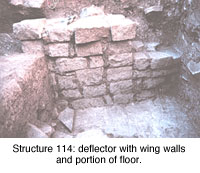 Excavations
within Structure 114, located in the north-central portion of the roomblock,
began with a 2-x-2-m unit in the south-central portion of the pit structure.
The unit was reduced to a 1-x-2-m unit when burned roof-fall deposits
were encountered. The western half of the 2-x-2-m unit was excavated to
floor. Collapsed roof materials, including primary beams, were in found
in direct contact with the structure floor. Several wood samples were
collected for tree-ring dating. The floor assemblage was sparse, consisting
of one Late White Unpainted rim sherd and two corrugated body sherds.
A hearth was revealed in the central portion of the 1-x-2-m unit. The
western half of the circular hearth was excavated, and 14 liters of ash
were collected for flotation analysis. Three rim sherds, a ladle fragment,
and one corrugated body sherd were recovered from the hearth fill. A masonry
deflector was constructed with low, coursed-masonry wing walls extending
to the southwest and southeast, probably to the structure bench face.
The central portion of the deflector is approximately 58 cm high, which
is almost double the height of the eastern and western wing walls. The
western wing wall was exposed to floor within the 1-x-2-m unit; the wall
was curved toward the south. A niche in the southwestern portion of the
western wing wall was excavated; it contained no artifacts, indicating
the niche contents were removed prior to abandonment. The architectural
style, the mode of abandonment, and the presence of Late White Unpainted
pottery sherds on the floor and in the hearth indicate that Structure
114 was abandoned during the Pueblo III period (A.D. 1150–1300).
Excavations
within Structure 114, located in the north-central portion of the roomblock,
began with a 2-x-2-m unit in the south-central portion of the pit structure.
The unit was reduced to a 1-x-2-m unit when burned roof-fall deposits
were encountered. The western half of the 2-x-2-m unit was excavated to
floor. Collapsed roof materials, including primary beams, were in found
in direct contact with the structure floor. Several wood samples were
collected for tree-ring dating. The floor assemblage was sparse, consisting
of one Late White Unpainted rim sherd and two corrugated body sherds.
A hearth was revealed in the central portion of the 1-x-2-m unit. The
western half of the circular hearth was excavated, and 14 liters of ash
were collected for flotation analysis. Three rim sherds, a ladle fragment,
and one corrugated body sherd were recovered from the hearth fill. A masonry
deflector was constructed with low, coursed-masonry wing walls extending
to the southwest and southeast, probably to the structure bench face.
The central portion of the deflector is approximately 58 cm high, which
is almost double the height of the eastern and western wing walls. The
western wing wall was exposed to floor within the 1-x-2-m unit; the wall
was curved toward the south. A niche in the southwestern portion of the
western wing wall was excavated; it contained no artifacts, indicating
the niche contents were removed prior to abandonment. The architectural
style, the mode of abandonment, and the presence of Late White Unpainted
pottery sherds on the floor and in the hearth indicate that Structure
114 was abandoned during the Pueblo III period (A.D. 1150–1300).
Structure 119
Excavations within
Structure 119, located in the south-central portion of the roomblock,
began with a 2-x-2-m unit in the south-central portion of the pit structure.
Excavations exposed the pilasters on either side of the southern recess,
a portion of the bench face, and the ventilator opening. The pilasters
had been heavily eroded; only the two basal courses were intact on the
eastern pilaster, and one course was preserved on the western pilaster.
The southern portion of the bench face, containing the ventilator opening,
was set back approximately 15 to 20 cm from the surrounding bench face,
indicating possible remodeling.
When unburned roof-fall
deposits were encountered, the unit was reduced to a 1-x-2-m unit and
the central portion of the structure was excavated to floor. Roof-fall
deposits lacked primary beams, and secondary roofing beams were poorly
preserved. The primary beams thus appear to have been recycled before
abandonment or shortly thereafter, and the roofing sediments were collapsed
directly on the floor. The floor assemblage was sparse, consisting of
a mano, a jar handle, two body sherds, and a lithic core. A hearth was
exposed in the north-central portion of the 1-x-2-m unit. The southeastern
quarter of this circular hearth was excavated, and 12 liters of ash were
collected for flotation analysis. Four sherds, including one Mancos or
McElmo black-on-white rim, and fragments of an unfired corrugated jar
were recovered from the hearth fill. The artifact assemblage and depositional
sequence indicate that Structure 119 was occupied during the Pueblo II
period (A.D. 900–1150) and that portions of the structure, including
the primary roofing beams and the deflector, were intentionally removed.
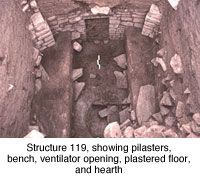 Wind-and-water
laminae were deposited directly above the roof fall, indicating that the
structure depression was open to the elements for a period of time. Approximately
20 cm of secondary refuse was then deposited above the natural sediments.
It seems plausible that this refuse was discarded by occupants residing
in Structure 114, indicating that surrounding structures continued to
be occupied after Structure 119 was abandoned.
Wind-and-water
laminae were deposited directly above the roof fall, indicating that the
structure depression was open to the elements for a period of time. Approximately
20 cm of secondary refuse was then deposited above the natural sediments.
It seems plausible that this refuse was discarded by occupants residing
in Structure 114, indicating that surrounding structures continued to
be occupied after Structure 119 was abandoned.
Excavations in structures
107, 108, 113, 115, and 118 in Architectural Block 100 were not completed
during the 2001 field season. These excavations will resume in the spring
of 2002.
Architectural Block 200
During the 2001 field season, one 1-x-1-m unit (410N 575E) was excavated in Nonstructure 201, a nonarchitectural stratified cultural deposit in Architectural Block 200 (Figure 2). This unit was not completed; excavations will resume in the spring of 2002.
Architectural Block 300
Fifteen 1-x-1-m units and two 2-x-2-m units (Figure 2) were excavated in Architectural Block 300 this season. Fifteen 1-x-1-m units were placed in Nonstructure 301, a midden deposit associated with a roomblock to the north. Midden deposits within Nonstructure 301 ranged from 15 to 39 cm thick. The excavation units were completed during the 2001 field season.
Structures 302 and 303
Structures 302 and 303, pit structures, were tested with 2-x-2-m units. Approximately 88 cm of natural, postabandonment deposits were removed from Structure 302, and approximately 58 cm of natural, postabandonment deposits were removed from Structure 303. Excavations will resume in these structures in the spring of 2002.
Architectural Block 400
Fifteen 1-x-1-m units and two 2-x-2-m units (Figure 2) were excavated in Architectural Block 400 during the 2001 season. The 1-x-1-m units were located in Nonstructure 401, a midden deposit associated with the surface rooms and Structures 402 and 403 (pit structures). Four of the 1-x-1-m units (419N 489E, 419N 490E, 422N 490E, and 420N 491E) contained a high density of midden deposits. Two 1-x-1-m units (430N 519E and 430N 520E) contained abundant sandstone fragments, caliche, and a few pottery sherds. This deposit has been interpreted as construction refuse.
Structure 402
Excavation within Structure 402, located on the southeastern side of the roomblock, began with a 2-x-2-m unit in the northeastern portion of the pit structure. A portion of an upper-lining wall and a pilaster were exposed in the northeastern portion of the excavation unit. The coursed-masonry upper-lining wall and the pilaster were in poor condition because of slumping and weathering. To protect the architecture, excavations were terminated in the eastern portion of the excavation unit. Excavations in the western portion of the excavation unit continued until the floor was exposed.
Burned roof fall, including primary beams, rested on the floor surface; the roof was probably intentionally burned prior to abandonment. Numerous burned wood samples were collected for tree-ring analysis. The occupants of Structure 402 used sandstone bedrock as a floor surface. This bedrock exhibited use-surface alterations, including a shallow basin that had been abraded into the sandstone to create a hearth and an adobe hearth collar that was constructed north of the hearth. A circular hearth was located in the southwestern corner of the 1-x-2-m unit. At the center, the hearth was 16 cm in depth. Approximately one-third of the portion of the hearth within the excavation unit was excavated, and six liters of ash were collected for flotation analysis. The only floor artifact was a white ware ladle fragment located east of the hearth.
Structure 403
Excavation in Structure 403, located southwest of the surface rooms, began with a 2-x-2-m unit in the south-central portion of the pit structure. Excavation in the 2-x-2-m unit continued through natural postabandonment deposits until burned roof-fall deposits were encountered. The unit was then divided into two 1-x-2-m units, and the eastern unit was excavated to floor. Numerous charred wood samples, including primary beams, were collected for tree-ring analysis. The floor of Structure 403 was a prepared adobe surface; all floor artifacts were removed prior to abandonment. The eastern half of a circular hearth was exposed in the northwestern portion of the excavation unit; the western half of the hearth was outside the excavation unit. The southeastern quarter of the hearth was excavated, and 12 liters of ash were collected for flotation analysis. The deflector had been partially dismantled prior to abandonment; only two basal courses remained.
Three lines of evidence indicate that Architectural Block 400 was occupied in the Pueblo III period (A.D. 1150–1300). First, a tower is present south of Structure 403, and it is probably connected to the pit structure by an subterranean tunnel. Towers were not common in the Mesa Verde region before A.D. 1150 (Varien 1999a). Second, a Mesa Verde Black-on-white sherd was recovered from roof-fall deposits, approximately 5 cm above the floor of Structure 402. Mesa Verde Black-on-white pottery was not made before A.D. 1180 in the Mesa Verde region (Ortman, personal communication, 2001). The third and final factor is the mode of abandonment exhibited in Structures 402 and 403. Intact floor assemblages and intentionally burned roofing materials, including primary beams, are commonly seen in the Pueblo III period (Duff and Ryan 2001).
Architectural Block 500
Five 1-x-1-m units and one 2-x-2-m unit (Figure 2) were excavated in Architectural Block 500 during the 2001 field season. The five 1-x-1-m units were located in Nonstructure 501, a midden deposit associated with a small rubble mound north of Structure 502, a pit structure. Four of the five 1-x-1-m units (446N 479E, 447N 480E, 450N 483E, and 456N 486E) contained midden deposits ranging from 32 to 43 cm thick. One 1-x-1-m unit (456N 486E) contained the west half of a pit feature. The portion of this basin-shaped pit exposed in the excavation unit measured 81 cm long, 55 cm wide, and 54 cm deep. The function of the pit is unknown due to the lack of distinguishing characteristics; it was a receptacle for secondary refuse after the pit was no longer utilized for its original purpose. The pit was most likely in an extramural area used by the occupants of Structure 502.
Structure 502
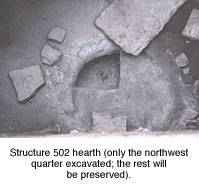 Excavations
in Structure 502, located just southeast of the small rubble mound, began
with a 2-x-2-m unit located in the central portion of the pit structure.
Excavations proceeded through natural, postabandonment deposits until
unburned roof-fall deposits were reached. The unit was then subdivided
into two 1-x-2-m units, and the southern unit was excavated to floor.
Roof-fall deposits lacked primary and secondary beams. It appeared that
the beams were intentionally recycled prior to abandonment, leaving the
roofing sediments to collapse directly on to the kiva floor.
Excavations
in Structure 502, located just southeast of the small rubble mound, began
with a 2-x-2-m unit located in the central portion of the pit structure.
Excavations proceeded through natural, postabandonment deposits until
unburned roof-fall deposits were reached. The unit was then subdivided
into two 1-x-2-m units, and the southern unit was excavated to floor.
Roof-fall deposits lacked primary and secondary beams. It appeared that
the beams were intentionally recycled prior to abandonment, leaving the
roofing sediments to collapse directly on to the kiva floor.
Several artifacts
were found on the floor of Structure 502 including two mano fragments,
three lithic fragments, a corrugated body sherd, a Mancos Black-on-white
rim sherd, a McElmo Black-on-white rim sherd, a Mesa Verde Black-on-white
rim sherd, portions of a hatch cover, and a decapitated snake skeleton.
A circular hearth was located in the south-central portion of the unit
and extended outside the excavation unit to the south. The northwestern
quarter of the hearth was excavated, and 16 liters of ash were collected
for flotation analysis. The presence of a Mesa Verde Black-on-white sherd
in contact with the structure floor suggests that Structure 502 was abandoned
after A.D. 1180, during the Pueblo III period (A.D. 1150–1300).
Goals for the 2002 Field Season
Excavation during
the 2002 field season at the Albert Porter Preserve will continue to follow
Crow Canyon's research design. All excavation units located in architectural
blocks 100, 200, and 300 that were not completed and backfilled during
the 2001 season will continue to be excavated and documented, and will
be backfilled when completed. New excavations will begin in eight pit
structures and eight midden areas that have not been sampled (architectural
blocks 600, 700, 800, and 900). Surface artifacts will be collected within
a 3-m radius of each 20-x-20-m grid center point to obtain quantitative
data on site density, subsurface cultural deposits, and the range of occupation
at the site. Between five and 10 rooms within Architectural Block 100
will be tested with a 1-x-2-m unit during the 2002 field season. Excavation
units placed within these rooms will allow us to observe construction
details, evidence of remodeling, and key features that could be significant
in identifying a Chacoan presence at the Albert Porter Preserve. Remote
sensing data indicates at least 36 possible cultural anomalies west, north,
east, and southeast of Architectural Block 100 (Figure
5). With permission from the Archaeological Conservancy, limited testing
will begin on selected anomalies during the 2002 field season. All pottery
and stone artifacts collected during the 2001 field season are currently
being processed for analysis. Tree-ring samples will be prepared for analysis
in January 2002. All special samples (for example, nonhuman bone and pollen)
will be analyzed upon the project completion.
The Albert Porter
Preserve appears to have been a community center for the Woods Canyon
community in the Mesa Verde region. Continued research in 2002 will further
add to our understanding of this significant site and its relationship
to other communities in the northern San Juan region.
List
of references cited
How to cite this publication
REMINDER: Archaeological resources are protected by federal laws, and archaeological research is guided by a set of professional ethics. See Archaeological Ethics and Law.
© Copyright 2002 by Crow Canyon Archaeological Center. All rights reserved.
 DONATE TODAY
DONATE TODAY
